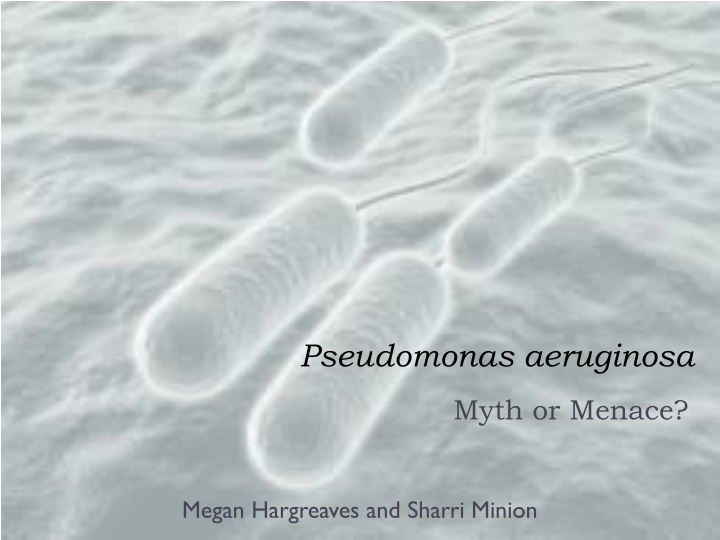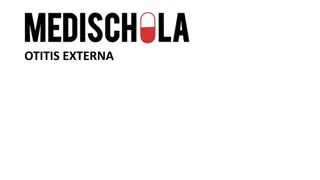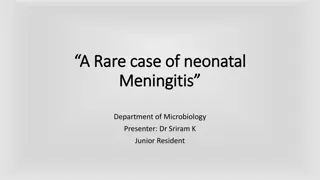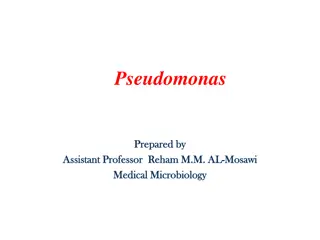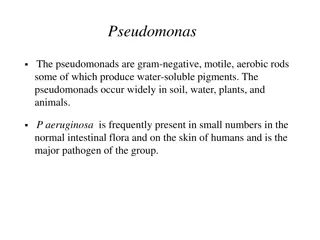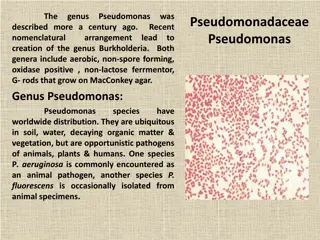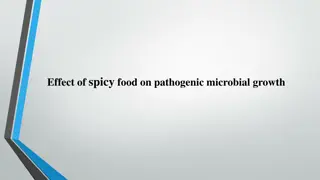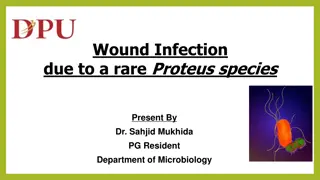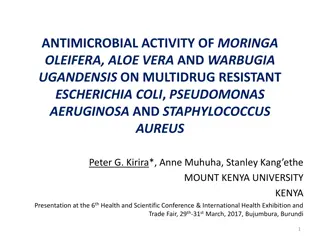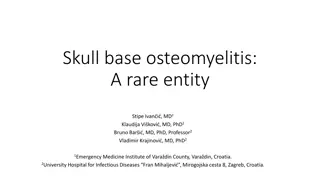Pseudomonas aeruginosa
Pseudomonas aeruginosa is a significant bacterium known in environmental and clinical microbiology. This article delves into its various habitats, including water, soil, plant tissues, and its role as an opportunistic pathogen in clinical settings. The focus on Pseudomonas aeruginosa in the context of environmental microbiology research, particularly its colonization of salad vegetables, reveals potential sources of this bacterium in human health. The study explores the risks associated with consuming raw salad vegetables potentially contaminated with Pseudomonas aeruginosa from soil, compost, water, or hydroponic systems, emphasizing the need for thorough testing and awareness.
Download Presentation

Please find below an Image/Link to download the presentation.
The content on the website is provided AS IS for your information and personal use only. It may not be sold, licensed, or shared on other websites without obtaining consent from the author.If you encounter any issues during the download, it is possible that the publisher has removed the file from their server.
You are allowed to download the files provided on this website for personal or commercial use, subject to the condition that they are used lawfully. All files are the property of their respective owners.
The content on the website is provided AS IS for your information and personal use only. It may not be sold, licensed, or shared on other websites without obtaining consent from the author.
E N D
Presentation Transcript
https://encrypted-tbn3.gstatic.com/images?q=tbn:ANd9GcSdjfefPxYkVeP5ScHsYApcWJ4SYQKy0Tt-VvG97Trt9cFovwNX4Qhttps://encrypted-tbn3.gstatic.com/images?q=tbn:ANd9GcSdjfefPxYkVeP5ScHsYApcWJ4SYQKy0Tt-VvG97Trt9cFovwNX4Q Pseudomonas aeruginosa Myth or Menace? Megan Hargreaves and Sharri Minion
Why focus on Pseudomonas aeruginosa? Well known to environmental microbiologists Indigenous microbiota of water and soil, plant tissues Recently found to preferentially aerosolised from those sites into the atmosphere Well known to clinical microbiologists Commonly isolated as a opportunistic pathogen in debilitated patients Catheterised Urinary Tracts Cystic fibrosis lung colonisation Burn wounds, particularly large scale Famously resistant to most antibiotics, very hard to treat Not well known to food quality microbiologists 2
Environmental Microbiology Research Group study Pilot study regarding Salad Vegetables and Pseudomonas aeruginosa indicated potential of project Major study of sources of Pseudomonas aeruginosa colonization of CF lungs focussed on two potential sources: Person to person: human source Air/water/soil: environmental source Food-borne micro-organisms are often sourced from their environment, especially fruit and vegetable crops which can be contaminated by the air or water or soil or all three 3
And so to Salad Vegetables On the premise that: Salad vegetables are generally eaten raw Pathogens present in or on food may be aspirated or washed into the lungs Vegetables are grown in soil or compost and irrigated by sprayed water, or hydroponically (in water) We tested both the outer surface and inner pulp of the following salad fruit and vegetables: Lettuce iceberg type (grown in soil or hydroponically) Tomatoes Mushrooms (organic and non-organic) Alfafa sprouts http://www.vegetablesinfo.com/images/alfalfa-Sprouts.png 4
Treatment Vegetables were sourced from Supermarket, Greengrocer and Farmers Market All samples were collected directly into a sterile stomacher bag using gloved hands, chilled for transport to the laboratory Outer surfaces were rinsed, rinse water filtered, plated out Roots of lettuce were removed for separate testing Flesh of all samples was stomached and plated out in same way as washings https://encrypted-tbn0.gstatic.com/images?q=tbn:ANd9GcSCHCwTUg1GsHZoKgT5mXJzy3JyYdjbx9ICZyh9mXf3dzYpXkvKIXiyeg https://encrypted-tbn1.gstatic.com/images?q=tbn:ANd9GcSC_i_62SRxhEreEKov66bYVn5yP_P2dWQTzCBoOub6XwKMdq25LA 5
Three levels of identification stringency Level 1: Initial identification of Pseudomonas aeruginosa performed using Phenotypic tests culture and biochemical characteristics This gives a presumptive identification This level would usually be all that was done in food labs Level 2: Genotyping such as Real-time PCR (RT-PCR) Pseudomonas aeruginosa duplex RT-PCR reaction assay (PAduplex) Tests for conserved regions of genome, unique and exclusive to Pseudomonas aeruginosa Confirms the identity of the organism, while decreasing the probability of misidentification. 6
Three levels of identification stringency Level 3: Strain typing using Molecular (DNA) analysis Within the genome of confirmed Pseudomonas aeruginosa isolates, variation may still be found by this level of analysis Variants are known as strains Clones are strains that have been consistently found in a geographical area, in multiple patients ERIC-PCR is a quick PCR method that is typically used to screen isolates for clonality The resulting pattern provides a fingerprint of the organism which can be compared to each other to determine if any relationship exists between isolates Discrimination between isolates was shown to be very high 7
Results Level 1 Phenotypic ID Table 1a. Presumptive and confirmatory identification data including number of genotypes of Pseudomonas aeruginosa recovered from sampled vegetables. http://www.vegetablesinfo.com/images/alfalfa-Sprouts.png * Indicates that lettuce roots were treated as individual samples during analysis, being the additional 30 samples shown in the current table. 8
Comments on Table 1a results All categories of retailers (greengrocer, farmers markets, and supermarkets) contributed contaminated vegetables of some type. Farmers markets and supermarkets had contamination in/on all types of vegetables tested Fruit and vegetable shop s mushrooms and tomatoes were uncontaminated 9
Level 2 and 3: Genotyping and strain typing summary NUMBER OF DIFFERENT GENOTYPES FOUND PER BATCH NUMBER OF PRESUMPTIVE ISOLATES NUMBER OF CONFIRMED ISOLATES NUMBER OF SAMPLES TYPE OF VEGETABLE Leaves 30 74 23 8 Lettuce Roots 30 82 29 10 Mushrooms Whole 48 45 5 3 Sprouts Whole 36 10 3 2 Tomatoes Whole 36 18 14 5 TOTAL 150*/180 227 74 28 10
Level 1: Level 2: Level 3 Phenotyping: Genotyping: Strain typing Phenotypic methods are slow and subject to alterations in biochemistry profiles and phenotype expression 227 isolates were identified by phenotyping as potential Pseudomonas aeruginosa Genotyping confirms the identity of the Pseudomonas aeruginosa, decreasing probability of misidentification Of the 227 potential P.aeruginosa isolates, only 74 were confirmed using PA duplex (roughly 2/3 false positives) ERIC-PCR provides a fingerprint of the organism and compares strains to determine if any relationship exists between them Of the confirmed 74 Ps. a isolates, 28 different genotypes were identified 11
Results of surface vs flesh tests The great majority of the isolates were found on the outside of all of the vegetables (Table 2). A very small number of confirmed isolates were found inside a tomato, one sprout package and the roots of the several lettuce. Table 2: distribution of numbers of confirmed isolates recovered from vegetable tissue and on the external surfaces of various vegetables. NUMBER OF CONFIRMED ISOLATES RECOVERED TYPE OF VEGETABLE SURFACE TISSUE TOTAL Leaves 23 0 23 Lettuce Roots 23 6 29 Mushrooms Whole 3 2 5 Sprouts Whole 0 3 3 Tomatoes Whole 13 1 14 TOTAL 62 12 74 12
http://www.vegetablesinfo.com/images/alfalfa-Sprouts.png Significance of surface vs flesh results The finding of a majority of isolates from surfaces of vegetable suggests that the contamination is most likely due to handling, washing or similar If the growth source of soil or water were found to be contaminated (results not shown here), we might have expected to find more plant tissue contamination Lack of cross contamination of genotypes between vegetables at any single retailer, indicates that the contamination is unlikely to have occurred there 13
Send in the Clones Fig. 3. Digitised ERIC-PCR patterns and dendrogram analysis of Pseudomonas aeruginosa isolates from sampled raw salad vegetables including major and minor controls. The similarity index is indicated at the top of the plot. Px indicates pulsotype number AES is Australian epidemic strain and number indicates the strain; VIC1 is Victorian strain 1; SAx is the South Australian strain and the number is indicative of the strain; and TAS4 is Tasmanian strain 4 14
Analysis of Cloning results No clonal genotypes of P. aeruginosa were found in or on any vegetable tested However, there has been a possibility suggested that isolated strains may mutate into clonal strains after infection of a human host, similar to the genetic adaptations in CF patients Recent evidence supports a theory that environmental strains of P. aeruginosa are able to move to other environments, such as the CF lung, and survive because the organism is forced to mutate due to natural selection (Rau et al., 2010) Therefore, while the isolates recovered in this study may not have 100% correlation to commonly isolated clonal varieties, they may mutate into clonal strains, given favourable conditions. 15
Take home message Significance of proportion of isolates identified phenotypically as Pseudomonas aeruginosa that proved to be negative by PA-duplex (roughly 2/3). This finding has major implications regarding the use of direct PCR methods for food quality testing! Genotyping results indicated that strains are found more consistently within a type of vegetable, than within a retail outlet. This indicates that the contamination is more likely to have occurred on the farm, in storage or in transit to the retail outlet 16
And Finally Myth or Menace Certainly not a myth proved to be present on surface of many vegetables Degree of menace is yet to be confirmed Clonal strains were not found in or on vegetables Level of menace is likely to depend very much on host factors If salad vegetables are to be eaten by a debilitated or immune-suppressed person, extra care should be taken with washing of the ingredients. https://encrypted-tbn2.gstatic.com/images?q=tbn:ANd9GcSQ7qhhy6Gzp6LdeZrJkB8TrbDjpO7CAf7v582KczisMS6jtalp 17
References Anuj, S. N., D. M. Whiley, T. J. Kidd, S. C. Bell, C. E. Wainwright, M. D. Nissen and T. P. Sloots. 2009. Identification of Pseudomonas aeruginosa by a duplex real-time polymerase chain reaction assay targeting the ecfX and the gyrB genes. Diagnostic Microbiology and Infectious Disease, 63: 127-131. Curran, B., J. A. W. Morgan and D. Honeybourne. 2005. Commercial mushrooms and bean sprouts are a source of Pseudomonas aeruginosa. Journal of Clinical Microbiology, 43 (11): 5830-5831 Hardalo, C. and S. Edberg. 1997. Pseudomonas aeruginosa: Assessment of risk from drinking water. Critical Reviews in Microbiology, 23 (1): 47-75. Heijerman, H. 2005. Infection and inflammation in cystic fibrosis: A short review. Journal of Cystic Fibrosis, 4: 3-5. Kidd, T., K. Ramsay, H. Hu, P. Bye, M. Elkins, K. Grimwood, C. Harbour, et al. 2009. Low rates of Pseudomonas aeruginosa misidentification in isolates from cystic fibrosis patients. Journal of Clinical Microbiology, 47 (5): 1503-1509. Kominos, S. D., C. E. Copeland, B. Grosiak and B. Postic. 1972. Introduction of Pseudomonas aeruginosa into a hospital via vegetables. Applied Microbiology, 24: 567-570. Samadpour, M. 2001. Molecular typing of Pseudomonas aeruginosa in distribution systems.Seattle: Awwa Research Foundation and American Water Works Association. Shooter, R. A., E. M. Cooke, M. C. Faiers, S. M. O'Farrell and A. L. Breaden. 1971. Isolation of Escherichia coli, Pseudomonas aeruginosa, and Klebsiella from food in hospitals, canteens and schools. The Lancet, 2: 390-392. Stewart, T. 2009. Cystic fibrosis in Australia 2007. North Ryde: Cystic Fibrosis Australia. Syrmis, M. W., M. R. O'Carroll, T. P. Sloots, C. Coulter, C. E. Wainwright, S. C. Bell and M. D. Nissen. 2004. Rapid genotyping of Pseudomonas aeruginosa isolates harboured by adult and paediatric patients with cystic fibrosis using repetitive-element-based PCR assays. Journal of Medical Microbiology, 53: 1089-1096. Wright, C., S. D. Kominos and R. B. Yee. 1976. Enterobacteriaceae and Pseudomonas aeruginosa recovered from vegetable salads. Applied and Environmental Microbiology, 31 (3): 453-454. 18
